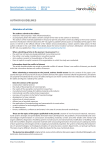Nanotechnologies in Construction: A Scientific Internet-Journal @nanobuild-en
Статьи журнала - Nanotechnologies in Construction: A Scientific Internet-Journal
Все статьи: 572
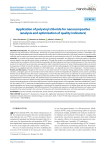
Статья научная
Introduction. The application of nanocomposites in various industries has increased in recent years due to their unique properties and performance characteristics. Enhancing the quality performance of nanocomposites presents a formidable challenge, primarily attributable to the intricate interactions among their constituent elements. This paper presents an overview of the methods used to analyze and calculate the quality performance of nanocomposites using PVC as the base material. Methods and materials. To calculate technological parameters that are not directly measurable, we conducted a thorough analysis of literature sources related to the specific process under consideration. Through this analysis, we established appropriate relationships between empirical data in accordance with the fundamental principles of thermodynamics and mass transfer processes. In the course of the research, the method of neural networks was applied in order to describe the process of vinyl chloride polymerization carried out by suspension method. To solve this problem, a cascade network with forward propagation of the signal and backward propagation of the error was applied. Network composition: in the hidden layer – ten sigmoid neurons, in the output layer – two linear neurons. Results and Discussion. Throughout this research, it was observed that the heat flux during polymerization exhibits temporal variation, contingent upon the concentration level of the initiator. Further the dependencies obtained can be used in controlling the flow rate of refrigerant into the reactor cooling jacket, to ensure that the entire process is isothermal. It was found that by varying the stirrer speed, it is possible to change the particle size and hence the molecular weight distribution of polyvinyl chloride. The developed neural network was tested. The obtained results have minimal error and are close to the real values, from which we can conclude that the network is trained correctly and the dependence between the data is found. Conclusion. Dependencies linking physicochemical parameters of the technological process with the design features of the apparatus have been established. To maintain the quality of PVC, in particular the appropriate molecular weight distribution, a neural network (a cascade network with direct signal propagation and reverse error propagation, consisting of ten sigmoidal neurons in the hidden layer and two linear neurons in the output layer) was developed in MATLAB environment. The network was trained on a sample and tested on test values, which showed that the network predicts the outcome of the process with minimal tolerable error, with other parameters unchanged.
Бесплатно
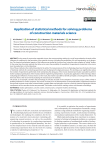
Application of statistical methods for solving problems of construction materials science
Статья научная
In the areas of construction materials science, the most promising solution is a set of issues related to the study of the influence of conditions for the formation of the material structure, including the possibilities of its self-organization, on its properties. The chemical and physical aspects of this influence are studied at the micro level, using the entire complex of “subtle” studies. At the same time, there are methods that allow us to assess the possibility of nanoeffects in experiments carried out at the macro level: in production or in the laboratory. One of these methods is the method described in the article. The main provisions of the methodology have been formed on the basis of statistical methods for conducting experiments and studying technological processes. This technique can significantly reduce the number of experiments performed while maintaining the adequacy of the results obtained and makes it possible to perform further analytical optimization of the results and their engineering interpretation. In particular, application of this technique allows evaluating joint influence of various factors on the result, that makes it possible to identify synergistic and antagonistic effects and then test them at the micro level by studying the nanostructure of materials. The article, as an example, considers the technology of concrete, focused on the utilization of concrete scrap as a filler or filler in building materials for various purposes. The results of research on the development of composite binder compositions based on fine-ground concrete scrap waste, mineral binder, synthetic fibers and polymers cured as a result of chemical interaction with the components of the concrete mixture are presented. This binder can be used for making various wall elements of buildings.
Бесплатно
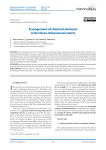
Arrangement of chemical elements in the three-dimensional matrix
Статья научная
It is emphasized in the article that thanks to the discovery of D.I. Mendeleev and the Periodic Table of chemical elements existing for more than 150 years, as well as the international table IUPAC, chemistry has been actively developing and keeps developing. A new model for arranging chemical elements in the form of a three-dimensional matrix has been proposed. This makes it possible to predict new elements with the designation of nuclear masses and the electronic structure of shells. There have been developed new patterns according to the cyclicity (block structure) of horizontal rows and the structure of vertical groups and their physical conception have been specified.
Бесплатно
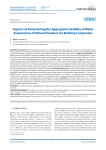
Статья научная
Introduction. When using water suspensions of finely dispersed mineral systems of natural and anthropogenic origins as active agents in the production of concrete composites, an important factor in their effective use is to ensure the aggregative and sedimentation stability of solid phase particles before adding the solid phase into the reaction mixture. Methods and materials. The paper provides an algorithm for quantifying stability criteria according to the DLVO theory provisions as exemplified by a suspension of fine polymineral sand powder from the Kholmogorskoye deposit in the Arkhangelsk region (average particle size is 195 nm). In order to successfully assess the aggregative stability of this colloidal system, it is necessary to conduct experiments for determining the analogue value of the Hamaker constant, which was 0.5 •10–20 J for the mineral sand studied, in addition to experiments for determining the zeta potential of particles. This paper presents the results of the analysis according to the criteria of the value of the interaction energy (Uint) and the sedimentation rate (Vsed) of a polymineral sand dispersed system (water suspension) calculated taking into account the analogue value of the Hamaker constant, zeta potential and dimensional characteristics of its solid phase particles, physicochemical properties of the dispersion medium. Results and discussion. It is shown that the determining factor of the aggregative stability of the suspension is the electrostatic barrier for particle interaction. Theoretical calculation showed that the aggregative stability of the system may be affected by its particles reaching their zeta potential of approximately 10–4 mV (a nearly isoelectric state). It is proposed to use the kinetic parameter of sedimentation – its velocity – to assess the kinetic (sedimentation) stability of this suspension – resistance to gravity, i.e. the ability to resist the dispersed system stratification due to the difference in particle densities between the dispersed phase and dispersion medium. Conclusion. The sedimentation rate is Vsed ≈ 4 nm/sec for the object under study in water dispersion medium with the averaged dimensional characteristics of 195 nm. At such a rate of solid phase particle precipitation, a dispersed system based on finely crushed polymineral sand from the Kholmogorskoye deposit can be considered sedimentatively stable.
Бесплатно
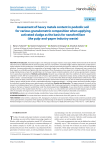
Статья научная
Introduction. Activated sludge is one of thepulp-and-paper industry waste types. Within the framework of the rational natural resources’ utilizationand the waste recycling, due to its composition, activated sludge could be subjected to certain technological solutions for the production of nanofertilizers, since it has been previously the basis for making of various soils and biological products. However,occasionally the composition of activated sludge may contain different toxic compounds, heavy metals, and their impact on soil fertility and plants vital state is profound. Thus, the purpose of our research is to study the effect of the activated sludge introductionas a basis for nanofertilizers on the heavy metals contentin podzolic soils of various granulometric composition in agricultural exploitation. Methods and materials. Research was conducted under the conditions of dummy experimentin vegetation vessels. We have used podzolic soils of various granulometric composition (clayey, loamy, sandy) and pulp-and-paper industry waste – activated sludge in concentrations of 1; 2.5; 5 and 10% of the dried soil weight. Determination of the heavy metals gross content has been carried out by the atomic absorption method with measurement on the AA-7000 spectrophotometer (Shimadzu, Japan); mobile fraction of heavy metalsdetermination (подвижныеформы) – utilizing acetate-ammonium buffer solution by inductively coupled plasma mass spectrometry methodology. Results and discussion. The paper presents the results of the research on mobileand gross forms of heavy metals in podzolic soil of various granulometric composition when applying activated sludge as the basis of organic nanofertilizer under the dummyexperiment. Conclusion. It was shown that the content of mobile and gross forms of the studied metals (Fe, Mn, Cu, Zn, Ti, Al, Ni, Co, Cr, Cd and Mo) were within the health-based exposure limits, with the exception of Cd gross form, where the maximum excess was 2.5 MAC (maximum allowable concentration).
Бесплатно
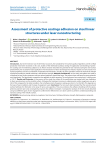
Assessment of protective coatings adhesion on steel linear structures under laser nanostructuring
Статья научная
Introduction. Due to the extensive use of steel linear structures, the standards for the surface quality of pipelines used for oil fluid production have been increased. In this case, studies of the interfacial boundary during the application and bonding of protective coatings are the interesting subjects to do. Recent research describes the potential of laser nanostructuring for steel surface pretreatment prior to polymer layer application. The introduction of laser technology into industry requires not only research on surface properties, but also an evaluation of operational characteristics. Usually, the semi-quantative criteria of mechanical strength of polymer bonding to metallic substrate is the adhesive strength. Methods and Materials. In this study, steel plates were used as a substrate for laser surface treatment with two pulsed ytterbium-doped fiber lasers. The polymer layer was based on epoxy-phenolic resin liquid paint. The liquid paint composition was applied via airless spraying. The curing process was carried out in a drying oven at 150 °C. Results and Discussion. In the process of the study, the surface of the metal plates was treated with laser irradiation to form nanostructures on the metallic surface. Following this treatment, increase in submicroscale surface roughness was up to 230–470% compared to the initial condition. Pull-of adhesion tests of polymer coating vary from 2.2 to 20.6 MPa. This depends on the type of laser irradiation and the type of equipment used. Conclusion. The test results demonstrated that the nanostructured surface facilitates the formation of an array of nano-scale asperities. This array enhances the adhesive bonding with the epoxyphenolic polymer layer and, consequently, improves the adhesive strength. A comparative analysis of the test results obtained using two different types of laser equipment confirmed the effectiveness of a laser system to perform combined polishing and nanostructuring of the metallic surface.
Бесплатно
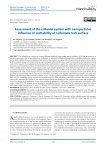
Статья научная
The wettability of a surface of channels filtering liquids and gases under natural conditions of oil and gas reservoirs is one of the parameters that largely determines the filtration. A nature of the filtration channel surface wettability determines a phase permeability, capillary forces and intensity of adsorption at the interface. An ability of the filtration channel surface to be wet by the polar or nonpolar phases of formation fluid and process liquids affects the filtration-capacitive parameters of oil and gas saturated rocks. In this regard, in the development of oil and gas fields, much attention is paid to the study of physicochemical phenomena and processes occurring at the interfaces. An article presents the results of a set of laboratory experiments to study the surface activity of the colloidal system in the form of an emulsion with supercharged nanoparticles. A set of filtration experiments was carried out using the United States Bureau of Mines (USBM) method in order to assess an effect of the emulsion system with nanoparticles on wettability of the surface of oil and gas reservoir rock filtration channels. The research was conducted on rock cores of two oil and gas fields in the Ural-Volga region of the Russian Federation. According to the applied experimental procedure, rock cores were preliminarily maintained under reservoir conditions to give a surface of pore channels the properties close to the natural conditions. After that, the wettability of rocks was assessed by measuring the USBM wettability index before and after filtering the emulsion system with nanoparticles. Analysis of the research results showed that filtration of the emulsion system with high surface activity led to a change in the wettability of rocks from completely hydrophilic (USBM index – 0.60) to completely hydrophobic (USBM index – minus 0.32). The research results allowed to conclude that there is a high potential for application of emulsion systems with supercharged nanoparticles to control the filtration of formation fluids and process liquids in natural oil and gas reservoirs.
Бесплатно
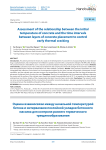
Статья научная
Introduction. This article presents the results of a study on the development of a concrete mix incorporating fly ash, blast furnace slag, a superplasticizer, and a temperature-rise inhibitor to produce concrete with a compressive strength of 60 MPa after 28 days. The concrete mixture is intended for use in a massive concrete foundation measuring 4 meters by 4 meters by 4 meters. Methods and materials. Laboratory tests were conducted to determine the compressive and tensile strength of the concrete. Additionally, tests were performed to evaluate the temperature rise under adiabatic conditions. Results. Using numerical simulation, the study investigated the influence of two factors on the temperature regime for the given concrete composition, Vietnamese climatic conditions, and the selected mass concrete structure: the temperature of the placed concrete and the time interval between the placement of adjacent blocks forming the mass. Discussion. Based on the requirement that the temperature difference between the center and the surface of the concrete mass should not exceed the permissible limit of 20 °C, an equation has been derived relating these two factors. Graphs of the corresponding functions have also been constructed. Conclusion. The research results can serve as practical guidelines for the construction of monolithic concrete foundations, helping to minimize the risk of thermal cracking and ensure the durability and quality of the structure.
Бесплатно

